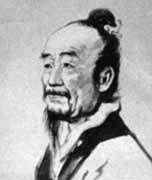Liu Hui | |
|---|---|
劉徽 | |
 | |
| Born | c. 225[1] |
| Died | c. 295[1] |
| Occupation(s) | Mathematician, writer |
| Liu Hui | |||||||||
|---|---|---|---|---|---|---|---|---|---|
| Traditional Chinese | 劉徽 | ||||||||
| |||||||||
Liu Hui (fl. 3rd century CE) was a Chinese mathematician who published a commentary in 263 CE on Jiu Zhang Suan Shu (The Nine Chapters on the Mathematical Art).[2] He was a descendant of the Marquis of Zixiang of the Eastern Han dynasty and lived in the state of Cao Wei during the Three Kingdoms period (220–280 CE) of China.[3]
His major contributions as recorded in his commentary on The Nine Chapters on the Mathematical Art include a proof of the Pythagorean theorem, theorems in solid geometry, an improvement on Archimedes's approximation of π, and a systematic method of solving linear equations in several unknowns. In his other work, Haidao Suanjing (The Sea Island Mathematical Manual), he wrote about geometrical problems and their application to surveying. He probably visited Luoyang, where he measured the sun's shadow.[3]
- ^ a b Lee & Tang.
- ^ "Liu Hui – Biography". Maths History. Retrieved 2022-04-17.
- ^ a b Stewart, Ian (2017). Significant Figures: The Lives and Work of Great Mathematicians (First US ed.). New York: Basic Books. p. 40. ISBN 978-0-465-09613-8.